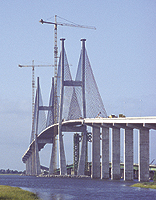With a 1,250-ft main span and a 185-ft clearance over a channel that leads to the Port of Brunswick, the new Sidney Lanier Bridge will allow larger ships to make calls there. The lift span bridge it replaces has a 139-ft clearance and allows a 250-ft channel width, says Lisa Sikes, Georgia Dept. of Transportation project engineer. Opelika, Ala.-based Scott Bridge Co. has just begun its $21-million contract to remove the old bridge.
 |
| STRIKING The longest cable-stayed bridge in Georgia was tough to build. (Photo courtesy of Georgia Ports Authority) |
Joint venture contractor Recchi/GLF, Miami, originally was scheduled to open the 1.5-mile-long bridge in December 2000. It now faces some $1 million in late penalties on its $65.5-million contract. "We are working to mitigate further accrual," says Brian West, project manager for Recchi/GLF.
In 2001, a $1-million custom-made form traveler from Europe being lowered with strand jacks slipped loose and fell. "You'd be hard-pressed to find a piece the size of a small car," says Craig Finley, senior vice president for Pasadena, Calif.-based Parsons Transportation Group, construction engineer for the team. Replacing the traveler added at least six months to the project.
With 485-ft-high towers and a coastal location, "you may have excellent working conditions at ground level, but there may be 50-mph winds at the upper tower elevations," says West. Tower crane work was suspended when sustained winds hit 45 mph. "The wind factor was not fully considered in the contract," he says.
The design by T.Y. Lin International, San Francisco, is similar to that of the Talmadge Bridge in Savannah and was spurred by the latter's popularity, says Man-Chung Tang, T.Y. Lin chairman. "Having built one cable-stayed bridge in Savannah, it was logical to use one in Brunswick," says Glenn Durrence, GDOT director of construction. But the Lanier bridge required marine-based construction, so the contractor built 300,000-ton granite islands in the 32-ft-deep channel.
Variations in the computer models of the designer and construction engineer caused discrepancies in wind load factors, traveler weight and camber and tie systems. Extra rebar and post-tensioning were needed, as was "a lot of ongoing discussion...to gain approvals borne out of variations on assumptions found in the two separate models," says West.
The contractor is challenging a $122,000 penalty proposed by the Occupational Safety and Health Administration, says West. This was for fall protection and other issues. There were no fatalities.
Half the cost of the new bridge is financed through the Coast Guard, since the old bridge constituted a "navigational hazard." Rosiek Construction, Arlington, Texas, completed an initial $18.9-million contract for the approach spans in 1998. "After this long battle, having the end in sight is nice," says West.
o the joy of both road and port officials, Georgia's longest cable-stayed bridge is set to open in a matter of days. A fallen traveler truss, geometry issues and high winds plagued the main span contract and contributed to a two-year delay.


Post a comment to this article
Report Abusive Comment